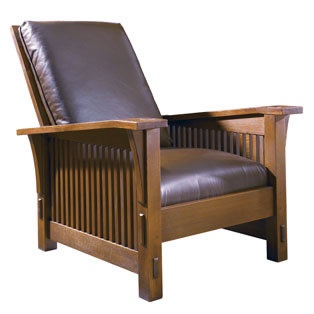 Years ago, I picked up a little handmade child’s chair at a thrift store for $20. I thought it was adorable. With its boxy low seat and wide arms, it looked a bit like a miniature Stickley Morris chair except that the rectangular back didn’t recline but folded forward for reasons no one could explain. It was possible it had been cleverly designed that way for easy storage. It was also possible I’d bought someone’s failed high school wood shop project.
Years ago, I picked up a little handmade child’s chair at a thrift store for $20. I thought it was adorable. With its boxy low seat and wide arms, it looked a bit like a miniature Stickley Morris chair except that the rectangular back didn’t recline but folded forward for reasons no one could explain. It was possible it had been cleverly designed that way for easy storage. It was also possible I’d bought someone’s failed high school wood shop project.
My young daughters rarely chose to sit in the chair. I hate to waste food and furniture so designated it the official “time-out chair” to ensure that it got plenty of use. The obedient, the childless, and the spectacularly good parents out there may be unfamiliar with the “time-out” concept. The idea was to give the child a place to pause and ponder her socially unacceptable behavior so she could emerge refreshed and reformed. It worked like magic for the first daughter. The second kid acted as if I was sentencing her to the electric chair.
Thanks to U, I now know why. Angular chair = scary monster bad. Curvy chair = happy, teddy love.
A new study conducted at Oregon State University compared the impact furniture has on our emotions. Researchers Sibel Dazkir and Marilyn Read showed more than 100 undergraduate students four virtual rooms. Two rooms contained angular furniture. Two contained rounded furniture. The virtual rooms appeared gray to avoid color and texture influences, and both the angular and curvy furniture was arranged in the same pattern. Students declared all the sparse rooms boring. But they rated the two rooms with curvy furniture significantly higher for pleasure and approachability.
“Most participants wanted to socialize in the curvilinear rooms more than the rectangular,” Dazkir said. “Curvy environments feel more pleasant because the shapes are more organic than sharp angles.”
Dazkir conducted the research for her master’s thesis at OSU and is currently pursuing a doctoral degree, researching the cultural aspects of environments. Read is an associate professor in the Department of Design and Human Environment at OSU. They found that curvy furniture evoked positive emotions. Respondents felt more happy, relaxed and hopeful with curves than angles. Rounded furniture was deemed more comfortable, interesting and calming compared to the rectangular furniture.
“Many commercial settings, like reception rooms that feel sterile, have rectangular forms,” Read said. “We want people to realize that simple changes, such as adding curvilinear form, in your home or office can make a big difference about how you feel in your environment.”
The journal Environment and Behavior intends to publish the study designed to guide interior designers and architects in creating welcoming environments with the use of curvy or rounded lines.
So is it better to have an angular time-out chair so that the child wants out quickly? Or is it better to use a warm and fuzzy curvy chair so the kid can comfortably contemplate past and future behavior?
Parenting through furniture is complicated. Mommy needs to lie down on the couch.




